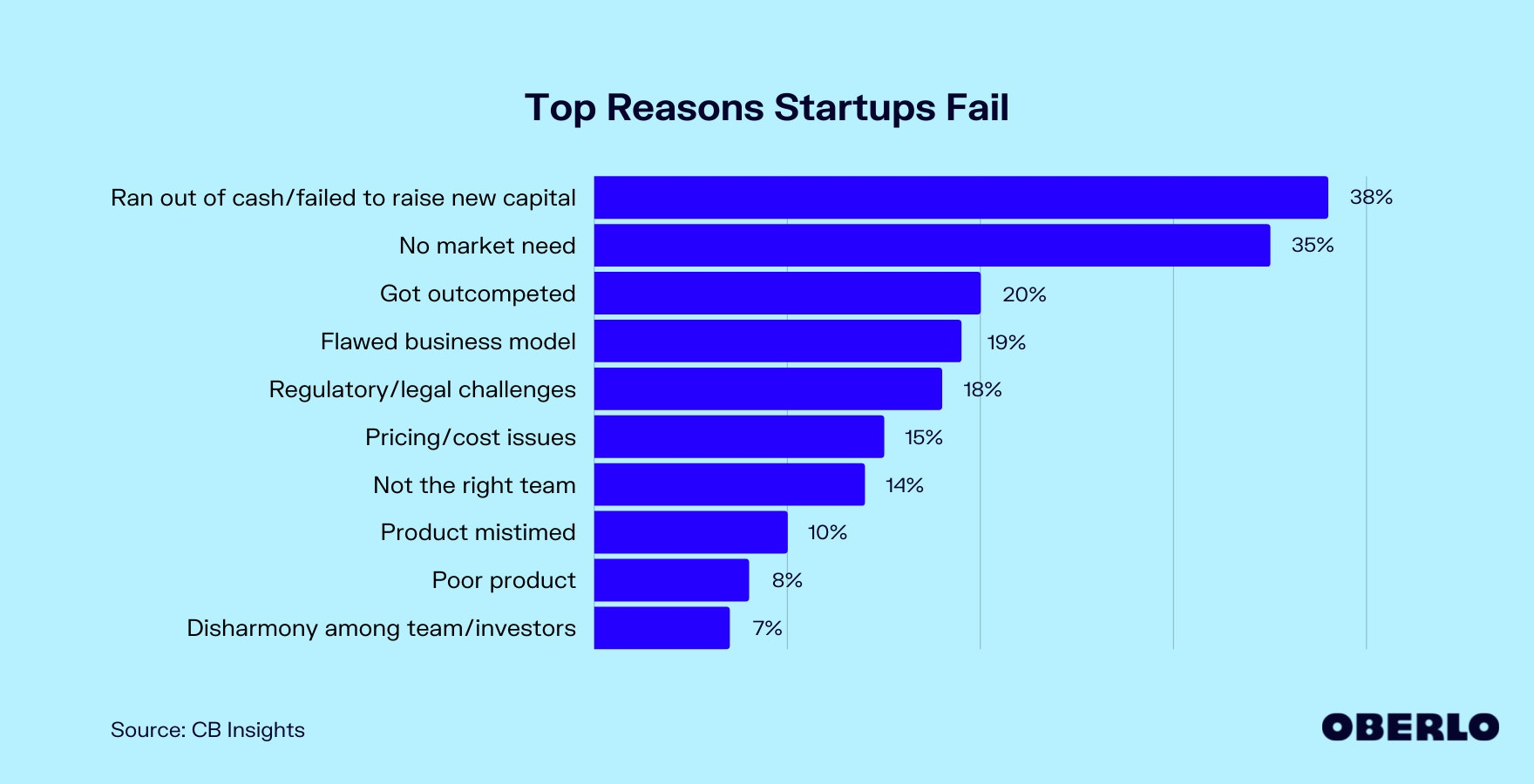Business competition will be fierce in 2022. With 5.82 million small business ventures now dominating the startup scene, the country has seen a 3.5% spike in startup applications since the onset of the pandemic.
While only 1.4 million of all business startups have more than ten staff members in full-time employment, a further 4.5 million are currently running on gig work and solo entrepreneurship alone.
On the back of increased small business pressures ranging from the impacts of inflation to a spike in e-commerce competition, maintaining a profitable venture in 2022 has become an ongoing challenge for startup entrepreneurs in the early stages of industry growth.
In fact, in the UK alone, less than 50% of small business ventures survive their third year of production.

(Image Source: Commerce Institute)
As you can see above, only 80% of businesses survive their first year in operation, while even fewer are profitable after five years. Statistically, the majority of startups fail within their first decade, rendering the fight for e-commerce success an uphill battle right from the start.
Stick with us as we deconstruct the modern-day startup sector and divulge our best-kept tips for venture success in 2022.
Are More Businesses Failing Post-Pandemic?
It’s no secret that the Covid-19 pandemic has had a significant effect on small business success. While there were more startup applications than ever before in 2020, 31% of small business ventures were non-operational as a result of lockdowns, high street closures and a lack of demand for a number of services.
In a post-pandemic playing field, business failure rates are still peaking as company owners scramble to battle the ongoing impacts of the global virus. As the corporate sector rebuilds and regenerates, Covid-19’s digital shift, coupled with the effects of inflation and a global labour shortage, has left a number of entrepreneurs struggling to stay afloat.
In response, new statistics from Writers Block Live have revealed that the new expected lifespan for a business venture is now only eight years, compared to over a decade in previous years.
The question is, just how much of an impact has the post-pandemic corporate scene had on small business success and what challenges are entrepreneurs facing? From an evolving e-commerce sector to a pullback in VC funding, let’s have a closer look at some of the key factors that are playing a role in company closures in 2022.
A Spike In E-commerce Competition
One of the key trends dominating the corporate sector in 2022 is e-commerce’s journey to global domination.
With a market size that is tipped to exceed a total of $5.55 trillion by the end of the year, e-commerce trading has become the most profitable retailing option for the average online entrepreneur in 2022.
Just two years ago, only 17% of all sales were attributed to an e-commerce retailer, but in a post-pandemic landscape, 21% of purchases are now completed on an online platform. In fact, the UK alone saw a 20% increase in e-commerce conversions as a result of shifting online trends. As online retail continues to expand, the adoption of conversion-enhancing technology within the sector has caught the eye of budding entrepreneurs looking to make a profit in a digital arena.
However, with e-commerce’s rising success, comes increasing competition within the industry for exposure, consumer retention and niche market domination. With smartphone-based e-commerce sales predicted to surpass $432 billion in 2022, smart entrepreneurs are battling it out to create the best mobile shopping apps and social media profiles to grip their demographic’s attention.
The issue here, is with increased competition, comes a higher number of venture failures. When competing in the same playing field as e-commerce giants such as Amazon, smaller startups can fall victim to going unnoticed within their niche. With a smaller following, a lack of large-scale funding and higher operational costs, many startups are lost within a sea of industry giants.
A Growing Demand For Automation
Covid-19 wreaked havoc on business ventures reliant on human labour. As factories closed their doors, supply chains drew to a halt, and the global labour force was forced inside, 80% of labour-reliant startups faced challenges linking to productivity and supply demand.
In order to tackle a global labour shortage, more industries than ever before have invested in widescale automation. Battling against a peak in online consumer demand, machines were employed to sift through large data sets, automate consumer feedback and manage supply chain efficiency.

(Image Source: Forbes)
By 2023, 24% of complex company decisions will be automated, alongside 23% of business forecasting. As the corporate sector adapts to a global technological shift, budding entrepreneurs must be prepared to embrace the powers of smart machine learning and AI technology.
Stepping into a new digital era of working, Mckinsey estimates that automation could put 400-800 million people out of a job by 2030. While the pandemic’s pressures have accelerated a technologically versed future, experts claim that the mainstream adoption of AI and fintech aids were inevitable as the world welcomed a digitally native generation.
While robotic aids are favoured by 92% of leading business powers, only half of the company processes within the corporate sector are currently automated. Whether it is attributed to technological scepticism or lack of small business capital, those who are shying away from automation should expect great challenges in 2022.
On the back of an e-commerce boom, consumer demand is at an all-time high. Business leaders that fail to automate their processes are likely to see a dip in productivity and may fail to meet shipping pressures, personalisation demands and stay on top of the market.
The Impacts Of Inflation
Inflation has hit a new high in 2022. Up from 9.0% in April, the most recent figures suggest that the current Consumer Price Index has hit 9.1%, posing great challenges to both consumers and startup entrepreneurs.
As employees ask for higher wages to compensate for the cost of living, employers will see a sharp increase in labour spending efforts in 2022, alongside a spike in supply chain costs, material expenditure and exportation.
“High inflation is squeezing small business owners while many are still in a crucial recovery period,” claims Simply Business CEO, Alan Thomas. “The eye-watering cost of Covid-19 for SME owners, including lost work, earnings and loan repayments, now sits at a total of £109.6 billion according to one of our recent surveys.”
Speaking on behalf of the small business sector, Thomas believes that a number of SMEs will struggle to recover from the costs of the pandemic, especially with the pressures of inflation weighing on their capital.
“One in six also believe they will never recover financially from the pandemic. As a result, two in five (46%) SMEs are calling for long-lasting financial support from the government to help them get back on their feet after Covid-19,” He stated in a recent interview.
As small business owners fight to stay afloat, a cash flow epidemic could be on the horizon. With a lack of capital killing four in ten startups in the first five years of operation, inflation could be the final nail in the coffin for SMEs without a sizable funding pot.
A Pull Back In VC Funding
Global venture funding also saw a sharp decline at the beginning of 2022. Reaching $39 billion in May, this was the first-month average VC funding dropped below $40 billion in more than a year, according to Crunchbase experts.
As VC investors and Angel funders move forward in an uncertain financial landscape, 2022 has seen the board market enter a deep recession, in turn raising the stakes to meet funding round demands. Instead, many VC investors are looking inwards this year, using capital to support their existing talents and boost their own portfolio, rather than piling money into new ventures.
For small business leaders, a pullback in VC funding could leave them facing capital-based challenges in the coming year. Statistics from Writers Block Live suggest that ventures backed by VC investment have a failure rate of just 25-30% in the first five years, which is significantly lower than the average fail rate for startups in a post-pandemic landscape.
As online entrepreneurs navigate the year ahead, the ride could be rocky as high numbers of startups compete for low numbers of funding options.
How Can You Protect Your Venture?
If you want to make sure your venture survives its first year in operation, it’s time to start taking steps to secure your success.
From securing an emergency fund to investing in technological aids, business leaders must move in line with the market if they want to rival competitors effectively. In an online landscape, the consumer is very much in control, meaning that budding entrepreneurs must follow their lead in terms of industry trends, social media marketing and, of course, UX design.
Those that prioritise user experience within their strategy are more likely to see higher levels of consumer retention and, in turn, a climbing return on investment.
Read on as we discuss the future of small business strategy planning, and divulge our best-kept success secrets, for business leaders hoping to dominate their niche in the next year.
Secure An Emergency Fund
Since the onset of the Covid-19 pandemic, only 40% of startups have claimed that they were profitable despite an influx of online competition.
In fact, 97% of small business owners have been concerned about their profit margins in the wake of post-pandemic recovery, inflation’s grip hold on the price increases and an impending e-commerce boom.
In 2022, lack of business funds and the failed ability to raise capital are the top causes of startup failure.

(Image Source: Oberlo)
According to CB insights, 38% of small business ventures fall into administration in just the first year on the grounds of cash flow issues alone.
Entrepreneurs that want to secure their place in the market in 2022 must be on top of their finances. Securing an emergency funding plan is a quick way to ensure business security during hardships, providing a safety net when expenditure is high, and returns are low.
There are a number of ways to build an emergency fund. From personal savings to small business loans, prioritising your cash flow plays a key factor in keeping your venture afloat during tough patches. For seasonal startups especially, an emergency fund is essential if your company is predicted to see dips in revenue at certain times of the year.
Here are some of our top cash-saving tips, that will see your emergency fund booming in the next year.
Put Aside A Portion Of Your Net Income: The key to effectively building a backup fund is consistency. Startup leaders that actively set aside a portion of their revenue each month are more likely to get into the habit of saving. Why not start with a simple 10% of the profits after expenditures and outgoings?
A Credit Line: If your credit score is positive, why not apply for a company line of credit? While you may never be in a position to use it, knowing the funding option is available, could encourage you to take calculated risks when progressing within the market.
SBA Loans: Turning to the Small Business Administration may be the last resort for many business leaders, but with a number of low-interest loans to pick from, companies that have been affected by a sudden financial disaster can greatly benefit from the capital injection.
Move In Line With the Market
Did you know that just under half of all businesses fail due to a lack of market need for products or services?
In order to ensure your venture stays afloat amongst the increasing competition, you need to be moving in line with market trends if you want to stay relevant to your demographic. Entrepreneurs that develop a business strategy based on the future direction of the industry are more likely to see a continued interest surrounding their products or services.
Success strategies in an online landscape need to be both consumer-focused and adaptable. The market is constantly evolving, and the birth of an active audience has meant that trends are constantly cropping up. Smart business leaders must create a product or service that can adapt to new demographic trends while also remaining unique next to competitors.
Knowing the market inside and out reduces startup risk as with an understanding of major trends dominating the sector, informed business decisions are more likely to lead to victory. Knowing your market is also key if you’re looking to provide a more targeted service to your customers. With a firm grasp on what your demographic is asking for, you can create a strategy that speaks to their values and gratifications.
To improve your own market outlook, it’s time to turn to first-party data and social listening techniques. By conducting a comparative market analysis using a number of data-based tools such as Google Analytics, you can measure your competitor’s success, and your own demographic engagement, and identify the industry trends emerging across various online platforms. Using this information, smart entrepreneurs can highlight their own competitive advantage in a niche market, and use it to influence future strategy planning.
Prioritise Personalisation
As more than 1.7 billion websites compete for user engagement, personalisation has become an essential ingredient for startup success. From streamlining the user experience to introducing targeted content, some of the most successful e-commerce giants have attributed their growth success to creating a tailored experience for their customers.
In fact, a recent study by Forbes found that 80% of online consumers are more likely to purchase a product/service from a company that directly targets them.
If you’re looking to make your startup venture last, it’s time to start prioritising your consumers. Companies who take time to introduce personalised messaging to their campaign strategy are twice as likely to see improved conversion returns.
It’s no secret that active audiences like to feel listened to. It’s your job as a business leader to represent their values within your content and make them feel as if the experience they receive on your site is unique to them.
Whether you introduce personalised chatbots to improve conversational marketing or invest in an AI-powered technology that can target site users with customised offers, If you strive to improve your user experience, you’ll see your consumer retention climbing and your returns improving.
In fact, experts at McKinsey claim that personalisation tactics alone can boost annual revenue by 15% while cutting acquisition costs in half.
Invest In Technology
One factor in particular that is significantly transforming the corporate sector is widespread digitalisation. On the back of Covid-19’s push for an online future, more small business owners than ever before have had to adapt to using digital aids within their strategy.
In fact, in 2022, 44% of SME leaders are speeding up their company’s digital transformation, while 36% are striving to improve their IT operations. Not only has widescale automation improved business productivity and training, but it is essential for data protection in a new online landscape.
“Modern IT infrastructures are more complex and sophisticated than ever, and the amount of virtual ground that we’ve got to safeguard has also grown exponentially,” claims Jesse Rothstein, CTO of data protection provisions, ExtraHop. “From mobile to desktop interactions, cybercriminals can launch thousands of digital attacks designed to compromise your operations at every turn, only one of which ever needs to connect to cause serious disruption.”
In order to escape cybersecurity attacks that could send your venture financially down the drain, it’s time to start investing in technological aids. After recent statistics revealed that just under half of all cyber breaches were aimed at small businesses, data hacking has become one of the leading causes of business failure.
While they are the prime targets for a security invasion, only 14% of startups are equipped to deal with the consequences of a cyber-attack. With the average data breach costing entrepreneurs up to $200,000, it’s no surprise that AI and blockchain security systems are being prioritised within the corporate sector.
Another technology that has revolutionised the small business sector is virtual and augmented reality. Known for transforming immersive training and improving WFH communication, AR/VR aids have become a popular tool for remote onboarders.
After a study from Chaos Theory Games revealed that VR implementation improved employee success by 70%, it could be time to introduce digital immersion to your business strategy.
Adopt A Growth Mindset
Last but not least, it’s time to strip back a business strategy to the source of success. Your mindset. An entrepreneur can have an abundance of business funding, technological aids and a positive position within the market and still fail to turn a profit if their head isn’t in the game.
Developing a growth mindset approach to your business venture is essential if you want it to thrive during its first year in operation. With undoubtable challenges ahead, business leaders must use hurdles as a chance to learn, rather than as a sign to hand in the towel.
In comparison to a fixed mindset, those with a growth approach to business management view failure as an opportunity to progress, and take criticism as a stepping stone for improvement. With a 20% fail rate in just the first year of operation, entrepreneurs must have a thick skin if they are to battle it out against large numbers of e-commerce competitors.
In order to keep growing, it’s important to connect with your audience and request feedback at every step of the growth journey. From UX design to customer service, the more feedback you receive, the better position you’ll be in when crafting future strategies.
While the first approach to entrepreneurial success may fail, those who truly win are those who never give up and face the 2022 startup market with both adaptability and resilience.








